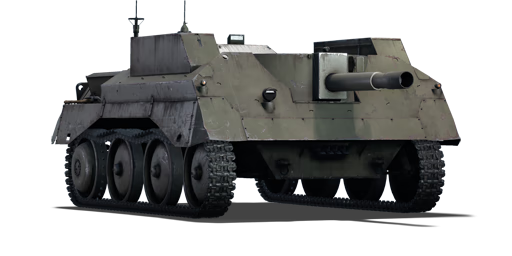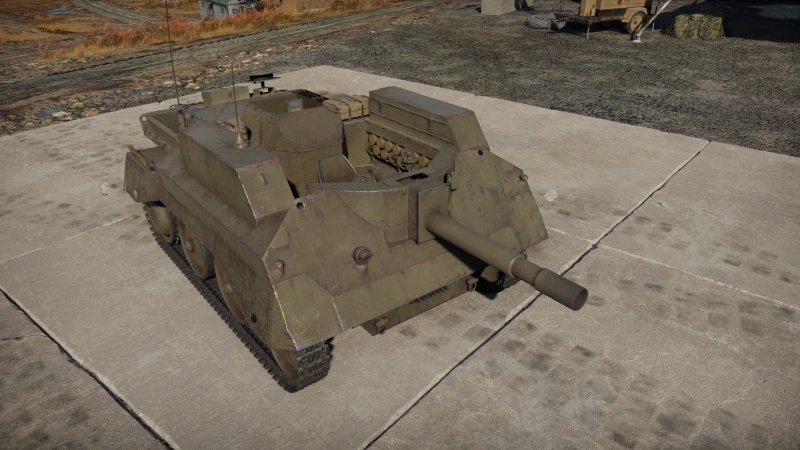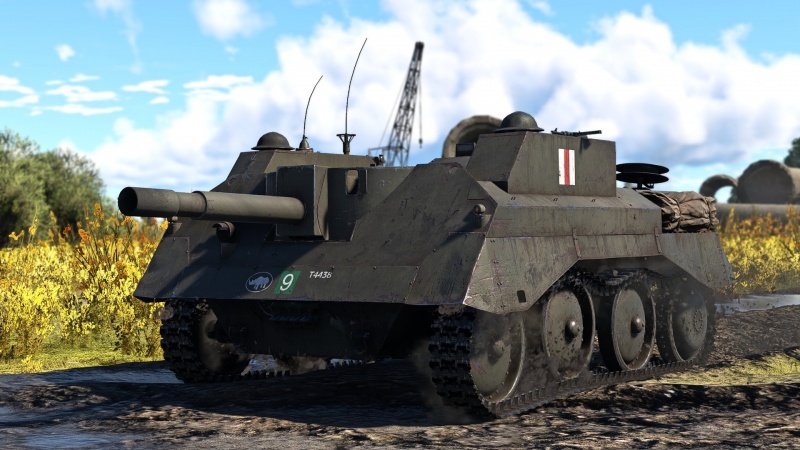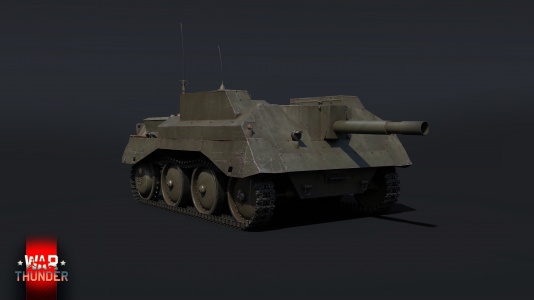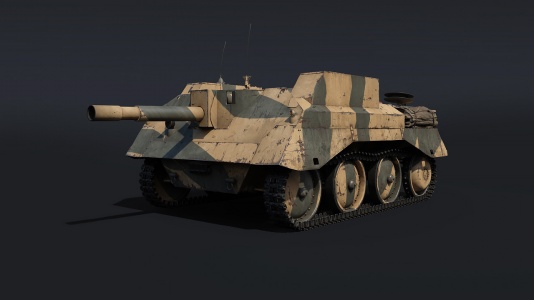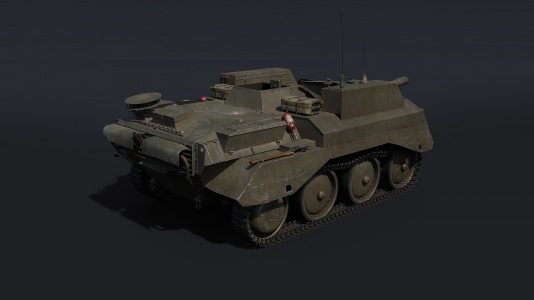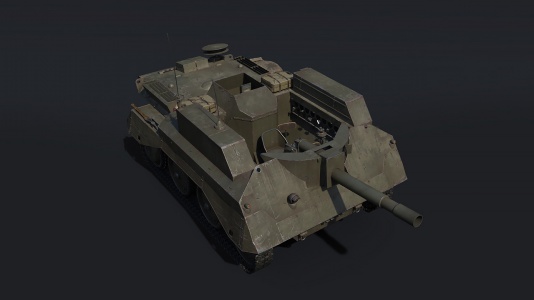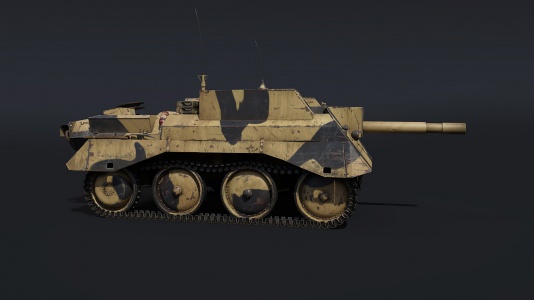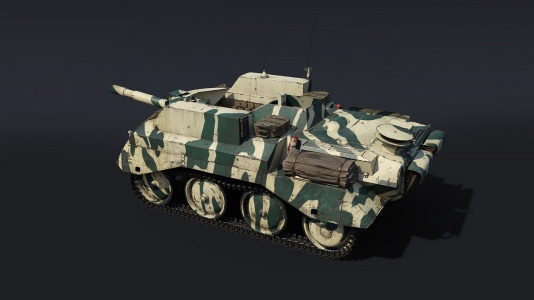Difference between revisions of "Alecto I"
(→Survivability and armour) (Tag: Visual edit) |
(→Description) |
||
| (3 intermediate revisions by 3 users not shown) | |||
| Line 7: | Line 7: | ||
== Description == | == Description == | ||
<!-- ''In the description, the first part should be about the history of the creation and combat usage of the vehicle, as well as its key features. In the second part, tell the reader about the ground vehicle in the game. Insert a screenshot of the vehicle, so that if the novice player does not remember the vehicle by name, he will immediately understand what kind of vehicle the article is talking about.'' --> | <!-- ''In the description, the first part should be about the history of the creation and combat usage of the vehicle, as well as its key features. In the second part, tell the reader about the ground vehicle in the game. Insert a screenshot of the vehicle, so that if the novice player does not remember the vehicle by name, he will immediately understand what kind of vehicle the article is talking about.'' --> | ||
| − | The ''' | + | The '''Alecto Mk.I''' was a British experimental light self-propelled gun, built on the basis of the Light Tank Mk.VIII "Harry Hopkins". Due to delays in development and testing of the Mk.VIII, the first chassis available for conversion into a self-propelled gun appeared only in August 1943. Testing and refinement of the Alecto itself, which began only in 1944, also dragged on considerably; as a result, a sample more or less ready for production only appeared by June 1945, when the need for such a machine had already disappeared, since there were more powerful and refined self-propelled guns available. A small batch of Alectos were produced, the exact number of which is unknown. They did not participate in combat operations, were used for training purposes and were scrapped by 1955. |
| − | + | Introduced during [[Update "Wind of Change"]] as a reward for the [[wt:en/news/7640-event-the-battle-for-arachis-en|"Battle for Arachis"]] event, the Alecto represents a classic "glass cannon". Its 95 mm howitzer is a very powerful weapon, with powerful HE and HEAT shells at its disposal, but it reloads quite slowly and surviving the reloading process in the enemy's sight is unlikely, since it has virtually no armour. However, it has satisfactory mobility and a very small profile, which somewhat increases its chances of survival. Constant repositioning and long-range firing will be crucial, as this is where the Alecto can excel. | |
| − | |||
| − | Constant repositioning and long-range firing will be crucial as this is where the Alecto | ||
| − | |||
| − | |||
== General info == | == General info == | ||
| Line 19: | Line 15: | ||
{{Specs-Tank-Armour}} | {{Specs-Tank-Armour}} | ||
<!-- ''Describe armour protection. Note the most well protected and key weak areas. Appreciate the layout of modules as well as the number and location of crew members. Is the level of armour protection sufficient, is the placement of modules helpful for survival in combat? If necessary use a visual template to indicate the most secure and weak zones of the armour.'' --> | <!-- ''Describe armour protection. Note the most well protected and key weak areas. Appreciate the layout of modules as well as the number and location of crew members. Is the level of armour protection sufficient, is the placement of modules helpful for survival in combat? If necessary use a visual template to indicate the most secure and weak zones of the armour.'' --> | ||
| − | + | The armour of the Alecto is quite poor. Rounds fired at you will penetrate, and the front is not even well sloped, so you can't bounce any shot. In addition, your ammo is stored entirely on the sides, so don't expect so do well if you get flanked. However, there is a benefit to poor armour: shots won't spall much (and often APHE won't detonate), so usually it will take multiple shots to take out your crew. But that does mean some rifle-calibre MG rounds can penetrate your armour frontally, so be careful of coaxial armament. Besides, don't forget though that you are open-topped, and are vulnerable to overpressure damage, besides being easy prey for enemy aviation. | |
'''Armour type:''' | '''Armour type:''' | ||
| Line 29: | Line 25: | ||
! Armour !! Front (Slope angle) !! Sides !! Rear !! Roof | ! Armour !! Front (Slope angle) !! Sides !! Rear !! Roof | ||
|- | |- | ||
| − | | Hull || 6 mm (36°) | + | | Hull || 6 mm (36°) ''Front glacis'' <br> 10 mm (7°) ''Lower glacis'' || 5 mm ''Top - Front upper plate'' <br> 6 mm (57°) ''Top - Front centre glacis'' <br> 5 mm ''Top - Front lower plate'' <br> 6 mm (33°) ''Top - Rear glacis'' <br> 10 mm (37°) ''Bottom'' || 10 mm ''Upper plate'' <br> 6 mm (36°) ''Lower glacis'' || 4 mm ''Engine compartment'' |
|- | |- | ||
| Gun shield || 10 mm (cylindrical) ''Turret front'' <br> 10 mm ''Gun mantlet'' | | Gun shield || 10 mm (cylindrical) ''Turret front'' <br> 10 mm ''Gun mantlet'' | ||
! | ! | ||
! | ! | ||
| − | ! | + | ! |
|- | |- | ||
|} | |} | ||
| Line 78: | Line 74: | ||
==== Ammunition ==== | ==== Ammunition ==== | ||
| − | { | + | {{:Howitzer, Tank No.1, Mk.I (95 mm)/Ammunition|Shell H.E./A.T., Shell Mk.Ia, Shell SE Mk.I}} |
| − | |||
| − | |||
| − | |||
| − | |||
| − | |||
| − | |||
| − | |||
| − | |||
| − | |||
| − | |||
| − | |||
| − | |||
| − | |||
| − | |||
| − | |||
| − | |||
| − | |||
| − | |||
| − | |||
| − | |||
| − | |||
| − | |||
| − | |||
| − | |||
| − | |||
| − | |||
| − | |||
| − | | Shell H.E./A.T. | ||
| − | |||
| − | |||
| − | |||
| − | |||
| − | |||
| − | |||
| − | |||
| − | |||
| − | |||
| − | |||
| − | |||
| − | |||
| − | |||
| − | |||
| − | |||
| − | |||
| − | |||
| − | |||
==== [[Ammo racks]] ==== | ==== [[Ammo racks]] ==== | ||
| Line 151: | Line 101: | ||
The HE and HEAT rounds come with the valuable bonus of overpressure damage, something often difficult to achieve on the 40 mm 2-Pounder gun due to the poor or lacking HE filler. At the rank, many lightly-armoured or exposed vehicles such as [[Panzerjager I|Panzerjäger I]] or [[Flakpanzer 38]] can be found; these will often become easy targets for the Alecto. | The HE and HEAT rounds come with the valuable bonus of overpressure damage, something often difficult to achieve on the 40 mm 2-Pounder gun due to the poor or lacking HE filler. At the rank, many lightly-armoured or exposed vehicles such as [[Panzerjager I|Panzerjäger I]] or [[Flakpanzer 38]] can be found; these will often become easy targets for the Alecto. | ||
| − | The fixed gun limits the close-range engagements since most tanks encountered will be agile enough to manoeuvre easily around the Alecto. Therefore the sniper role will favour this fixed gun design. | + | The fixed gun limits the close-range engagements since most tanks encountered will be agile enough to manoeuvre easily around the Alecto. Therefore the sniper role will favour this fixed gun design. The Alecto got nothing to envy in the mobility department, so the commanders could take advantage of the nimble chassis and find good sniping positions or be ready to relocate when necessary. |
| − | Something important to note is the limited elevation of the howitzer. Often the most irregular terrains such as those on [[Tunisia]], [[Ash River]] or [[Frozen Pass (Ground Forces)|Frozen Pass]] will be challenging for the Alecto. Not only on gun traversing but in practical firing positioning. Here is when knowledge of the map terrain will help players get the most out of the flexibility of Alecto's mobility. | + | Something important to note is the limited elevation of the howitzer. Often the most irregular terrains such as those on [[Tunisia]], [[Ash River]] or [[Frozen Pass (Ground Forces)|Frozen Pass]] will be challenging for the Alecto. Not only on gun traversing but in practical firing positioning. Here is when knowledge of the map terrain will help players get the most out of the flexibility of Alecto's mobility. |
Since no tank design is perfect, the Alecto will be no exception. The thin protection and the lack of any roof armour mean the tank can suffer from the lightest of the guns, namely 12.7 mm Browning machine guns and small calibre autocannons as those on the Anti-aircraft vehicles. Smart tankers should seek to never stay in the same position for too long, as enemy aircraft or revengeful players could find their way to you. The smoke shells can help in this regard. Whenever in trouble, a few smoke shells can obscure the enemy's sight enough for a retreat or a brave standoff up close and personal. Players should never forget to load some smoke rounds for the most desperate needs. | Since no tank design is perfect, the Alecto will be no exception. The thin protection and the lack of any roof armour mean the tank can suffer from the lightest of the guns, namely 12.7 mm Browning machine guns and small calibre autocannons as those on the Anti-aircraft vehicles. Smart tankers should seek to never stay in the same position for too long, as enemy aircraft or revengeful players could find their way to you. The smoke shells can help in this regard. Whenever in trouble, a few smoke shells can obscure the enemy's sight enough for a retreat or a brave standoff up close and personal. Players should never forget to load some smoke rounds for the most desperate needs. | ||
| Line 175: | Line 125: | ||
== History == | == History == | ||
<!-- ''Describe the history of the creation and combat usage of the vehicle in more detail than in the introduction. If the historical reference turns out to be too long, take it to a separate article, taking a link to the article about the vehicle and adding a block "/History" (example: <nowiki>https://wiki.warthunder.com/(Vehicle-name)/History</nowiki>) and add a link to it here using the <code>main</code> template. Be sure to reference text and sources by using <code><nowiki><ref></ref></nowiki></code>, as well as adding them at the end of the article with <code><nowiki><references /></nowiki></code>. This section may also include the vehicle's dev blog entry (if applicable) and the in-game encyclopedia description (under <code><nowiki>=== In-game description ===</nowiki></code>, also if applicable).'' --> | <!-- ''Describe the history of the creation and combat usage of the vehicle in more detail than in the introduction. If the historical reference turns out to be too long, take it to a separate article, taking a link to the article about the vehicle and adding a block "/History" (example: <nowiki>https://wiki.warthunder.com/(Vehicle-name)/History</nowiki>) and add a link to it here using the <code>main</code> template. Be sure to reference text and sources by using <code><nowiki><ref></ref></nowiki></code>, as well as adding them at the end of the article with <code><nowiki><references /></nowiki></code>. This section may also include the vehicle's dev blog entry (if applicable) and the in-game encyclopedia description (under <code><nowiki>=== In-game description ===</nowiki></code>, also if applicable).'' --> | ||
| − | The Alecto I is a British self propelled gun developed from the Tetrach light tank towards the end of the Second World War. Fitted with a newly developed 3.75 inch howitzer in an open top casemate configuration, the Alecto only completed trials after the war had ended, leading to it serving briefly with the British Army in Germany and the Middle East without seeing any combat. | + | The Alecto I is a British self propelled gun developed from the Tetrach light tank towards the end of the Second World War. Fitted with a newly developed 3.75 inch howitzer in an open top casemate configuration, the Alecto only completed trials after the war had ended, leading to it serving briefly with the British Army in Germany and the Middle East without seeing any combat. |
=== [[wt:en/news/7636-development-battle-for-arachis-alecto-mk-i-spg-en|Devblog]] === | === [[wt:en/news/7636-development-battle-for-arachis-alecto-mk-i-spg-en|Devblog]] === | ||
| − | A further development of the Tetrarch light tank concept resulted in the Mk.VIII Harry Hopkins light cruiser tank, which Vickers-Armstrongs was creating to be an airborne tank. Since the mass of the vehicle by the beginning of the production exceeded the allowable for the project, and the design itself still required serious improvements, the company's engineering team decided to continue their work, turning the project into a light self-propelled unit with a 3. | + | A further development of the Tetrarch light tank concept resulted in the Mk.VIII Harry Hopkins light cruiser tank, which Vickers-Armstrongs was creating to be an airborne tank. Since the mass of the vehicle by the beginning of the production exceeded the allowable for the project, and the design itself still required serious improvements, the company's engineering team decided to continue their work, turning the project into a light self-propelled unit with a 3.75" howitzer Q.F. 95mm. The chassis engine compartment was completely unified with the Harry Hopkins, while the combat compartment and the gun were completely new for the series. The SPG is called Alecto I (or Alecto Mk. I) went to the testing in 1944 and, after implementing new changes (again with an increase in the mass of the machine), the self-propelled guns were built in a small batch by June 1945. The war had already ended by that time, and all units built were used mainly for training purposes and were decommissioned in 1955. |
== Media == | == Media == | ||
| Line 210: | Line 160: | ||
* ''other literature.'' --> | * ''other literature.'' --> | ||
| − | * [[wt:en/news/7636-development-battle-for-arachis-alecto-mk-i-spg-en|[Devblog] | + | * [[wt:en/news/7636-development-battle-for-arachis-alecto-mk-i-spg-en|[Devblog] "Battle for Arachis": Alecto Mk. I SPG]] |
{{Manufacturer Vickers-Armstrongs}} | {{Manufacturer Vickers-Armstrongs}} | ||
{{Britain tank destroyers}} | {{Britain tank destroyers}} | ||
{{Britain premium ground vehicles}} | {{Britain premium ground vehicles}} | ||
Latest revision as of 09:13, 17 August 2024
Contents
Description
The Alecto Mk.I was a British experimental light self-propelled gun, built on the basis of the Light Tank Mk.VIII "Harry Hopkins". Due to delays in development and testing of the Mk.VIII, the first chassis available for conversion into a self-propelled gun appeared only in August 1943. Testing and refinement of the Alecto itself, which began only in 1944, also dragged on considerably; as a result, a sample more or less ready for production only appeared by June 1945, when the need for such a machine had already disappeared, since there were more powerful and refined self-propelled guns available. A small batch of Alectos were produced, the exact number of which is unknown. They did not participate in combat operations, were used for training purposes and were scrapped by 1955.
Introduced during Update "Wind of Change" as a reward for the "Battle for Arachis" event, the Alecto represents a classic "glass cannon". Its 95 mm howitzer is a very powerful weapon, with powerful HE and HEAT shells at its disposal, but it reloads quite slowly and surviving the reloading process in the enemy's sight is unlikely, since it has virtually no armour. However, it has satisfactory mobility and a very small profile, which somewhat increases its chances of survival. Constant repositioning and long-range firing will be crucial, as this is where the Alecto can excel.
General info
Survivability and armour
The armour of the Alecto is quite poor. Rounds fired at you will penetrate, and the front is not even well sloped, so you can't bounce any shot. In addition, your ammo is stored entirely on the sides, so don't expect so do well if you get flanked. However, there is a benefit to poor armour: shots won't spall much (and often APHE won't detonate), so usually it will take multiple shots to take out your crew. But that does mean some rifle-calibre MG rounds can penetrate your armour frontally, so be careful of coaxial armament. Besides, don't forget though that you are open-topped, and are vulnerable to overpressure damage, besides being easy prey for enemy aviation.
Armour type:
- Rolled homogeneous armour
| Armour | Front (Slope angle) | Sides | Rear | Roof |
|---|---|---|---|---|
| Hull | 6 mm (36°) Front glacis 10 mm (7°) Lower glacis |
5 mm Top - Front upper plate 6 mm (57°) Top - Front centre glacis 5 mm Top - Front lower plate 6 mm (33°) Top - Rear glacis 10 mm (37°) Bottom |
10 mm Upper plate 6 mm (36°) Lower glacis |
4 mm Engine compartment |
| Gun shield | 10 mm (cylindrical) Turret front 10 mm Gun mantlet |
Notes:
- Suspension wheels and torsion bars are 20 mm thick, while tracks are 15 mm thick.
- Belly armour is 6 mm thick.
- There is a 6 mm thick plate separating the crew compartment from the engine compartment.
- The driver seats in a compartment surrounded with 4 mm thick plates on the front and the sides.
- Mudguards are 4 mm thick.
Mobility
| Game Mode | Max Speed (km/h) | Weight (tons) | Engine power (horsepower) | Power-to-weight ratio (hp/ton) | |||
|---|---|---|---|---|---|---|---|
| Forward | Reverse | Stock | Upgraded | Stock | Upgraded | ||
| Arcade | 54 | 6 | 8 | 234 | 315 | 29.25 | 39.38 |
| Realistic | 50 | 6 | 146 | 165 | 18.25 | 20.63 | |
Modifications and economy
Armaments
Main armament
| 95 mm Howitzer, Tank No.1, Mk.I | Turret rotation speed (°/s) | Reloading rate (seconds) | |||||||||||
|---|---|---|---|---|---|---|---|---|---|---|---|---|---|
| Mode | Capacity | Vertical | Horizontal | Stabilizer | Stock | Upgraded | Full | Expert | Aced | Stock | Full | Expert | Aced |
| Arcade | 48 | -5°/+25° | ±15° | N/A | 8.8 | 12.2 | 14.8 | 16.4 | 17.4 | 11.18 | 9.89 | 9.12 | 8.60 |
| Realistic | 6.0 | 7.0 | 8.5 | 9.4 | 10.0 | ||||||||
Ammunition
| Penetration statistics | |||||||
|---|---|---|---|---|---|---|---|
| Ammunition | Type of warhead |
Penetration @ 0° Angle of Attack (mm) | |||||
| 10 m | 100 m | 500 m | 1,000 m | 1,500 m | 2,000 m | ||
| Shell H.E./A.T. | HEAT | 110 | 110 | 110 | 110 | 110 | 110 |
| Shell Mk.Ia | HE | 10 | 10 | 10 | 10 | 10 | 10 |
| Shell details | ||||||||||||
|---|---|---|---|---|---|---|---|---|---|---|---|---|
| Ammunition | Type of warhead |
Velocity (m/s) |
Projectile mass (kg) |
Fuse delay (m) |
Fuse sensitivity (mm) |
Explosive mass (TNT equivalent) (g) |
Ricochet | |||||
| 0% | 50% | 100% | ||||||||||
| Shell H.E./A.T. | HEAT | 502 | 6.72 | 0 | 0.3 | 781.66 | 62° | 69° | 73° | |||
| Shell Mk.Ia | HE | 320 | 11.34 | 0 | 0.1 | 666 | 79° | 80° | 81° | |||
| Smoke shell characteristics | ||||||
|---|---|---|---|---|---|---|
| Ammunition | Velocity (m/s) |
Projectile mass (kg) |
Screen radius (m) |
Screen deploy time (s) |
Screen hold time (s) |
Explosive mass (TNT equivalent) (g) |
| Shell SE Mk,I | 320 | 11.34 | 13 | 5 | 20 | 50 |
Ammo racks
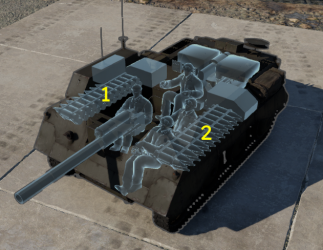
| Full ammo |
1st rack empty |
2nd rack empty |
Visual discrepancy |
|---|---|---|---|
| 48 | 25 (+23) | 1 (+47) | No |
Notes:
- Shells are modeled individually and disappear after having been shot or loaded.
Usage in battles
The Alecto's usage in battle could be somewhat monotonously difficult if no situational awareness or thoughtful positioning is used, due to the relatively poor defensive qualities of the SPG. Fortunately, This can be easily overcome when considering the vehicle's main traits. Therefore, the sniper role is, by far, the go-to role if a player wants to enjoy and learn the best out of the Alecto.
The decent ballistics of the gun and the capable HEAT shell can stand for some serious long-range shooting. Considering that most British tanks at its rank are armed with the 2-pounder, the Alecto provides an upper hand in long-range engagements due to the chemical rounds. This explosive sniper game style should not be overlooked, as it allows for an often enjoyable learning experience for latter gameplays as the FV4005 or the G6 Rhino.
The HE and HEAT rounds come with the valuable bonus of overpressure damage, something often difficult to achieve on the 40 mm 2-Pounder gun due to the poor or lacking HE filler. At the rank, many lightly-armoured or exposed vehicles such as Panzerjäger I or Flakpanzer 38 can be found; these will often become easy targets for the Alecto.
The fixed gun limits the close-range engagements since most tanks encountered will be agile enough to manoeuvre easily around the Alecto. Therefore the sniper role will favour this fixed gun design. The Alecto got nothing to envy in the mobility department, so the commanders could take advantage of the nimble chassis and find good sniping positions or be ready to relocate when necessary.
Something important to note is the limited elevation of the howitzer. Often the most irregular terrains such as those on Tunisia, Ash River or Frozen Pass will be challenging for the Alecto. Not only on gun traversing but in practical firing positioning. Here is when knowledge of the map terrain will help players get the most out of the flexibility of Alecto's mobility.
Since no tank design is perfect, the Alecto will be no exception. The thin protection and the lack of any roof armour mean the tank can suffer from the lightest of the guns, namely 12.7 mm Browning machine guns and small calibre autocannons as those on the Anti-aircraft vehicles. Smart tankers should seek to never stay in the same position for too long, as enemy aircraft or revengeful players could find their way to you. The smoke shells can help in this regard. Whenever in trouble, a few smoke shells can obscure the enemy's sight enough for a retreat or a brave standoff up close and personal. Players should never forget to load some smoke rounds for the most desperate needs.
Pros and cons
Pros:
- Highly capable HEAT; excellent for Rank I armour
- Excellent mobility for an SPG; fast acceleration and steering
- Flexible shell arsenal: smoke, HE and HEAT shells
- Sufficient ammo load for prolonged fighting
Cons:
- Long reload time; no match for fast-firing guns at the rank
- Thinly armoured and open-topped; easily destroyed
- Shell drop can provide difficult long range shooting, practice is needed
- Fixed gun design limits response time against faster tanks; poor elevation angles worsens this
History
The Alecto I is a British self propelled gun developed from the Tetrach light tank towards the end of the Second World War. Fitted with a newly developed 3.75 inch howitzer in an open top casemate configuration, the Alecto only completed trials after the war had ended, leading to it serving briefly with the British Army in Germany and the Middle East without seeing any combat.
Devblog
A further development of the Tetrarch light tank concept resulted in the Mk.VIII Harry Hopkins light cruiser tank, which Vickers-Armstrongs was creating to be an airborne tank. Since the mass of the vehicle by the beginning of the production exceeded the allowable for the project, and the design itself still required serious improvements, the company's engineering team decided to continue their work, turning the project into a light self-propelled unit with a 3.75" howitzer Q.F. 95mm. The chassis engine compartment was completely unified with the Harry Hopkins, while the combat compartment and the gun were completely new for the series. The SPG is called Alecto I (or Alecto Mk. I) went to the testing in 1944 and, after implementing new changes (again with an increase in the mass of the machine), the self-propelled guns were built in a small batch by June 1945. The war had already ended by that time, and all units built were used mainly for training purposes and were decommissioned in 1955.
Media
- Skins
- Images
See also
External links
| Vickers-Armstrongs Limited | |
|---|---|
| Ships | |
| Tribal-class | HMS Eskimo · HMCS Haida |
| Invincible-class | HMS Invincible* |
| Kongō-class | IJN Kongo** |
| Tanks | |
| Light Tanks | VFM5*** · Vickers Mk.11*** |
| Light Tank Mk VI | Light AA Mk I |
| Light Tank Mk VII | Tetrarch I |
| Light Tank Mk VIII | Alecto I |
| Tank, Infantry, Valentine | Valentine I · Valentine IX · Valentine XI · Archer |
| Vickers MBT | Vickers Mk.1 · Vickers Mk.3 · Vickers Mk.7*** |
| Heavy Tanks | Independent**** |
| Export | ▂МК-IX "Valentine" · Vickers Mk.E**** |
| See also | Vickers-Armstrongs Aircraft Limited |
| *Previously Armstrong Whitworth | |
| **Built for Japan | |
| ***Vickers Defence Systems | |
| ****Previously Vickers Limited | |
| Britain tank destroyers | |
|---|---|
| Infantry tank derivatives | Archer · Gun Carrier (3-in) |
| Light tank derivatives | Alecto I |
| M10 Achilles | Achilles · Achilles (65 Rg.) |
| Centurion derivatives | FV4005 · Conway |
| ATGM | Swingfire · Striker |
| Other | Tortoise · ▄M109A1 |
| Canada | QF 3.7 Ram |
| South Africa | G6 · ZT3A2 |
| Britain premium ground vehicles | |
|---|---|
| Light tanks | A13 Mk I (3rd R.T.R.) · A13 Mk II 1939 · AEC Mk II · Crusader "The Saint" · Rooikat 105 |
| Medium tanks | A.C.I · Grant I · Cromwell V (RP-3) · Sherman IC "Trzyniec" · A.C.IV · Comet I "Iron Duke IV" |
| Centurion Mk.2 · ▄Strv 81 (RB 52) · Centurion Mk.5 AVRE · Centurion Mk.5/1 · ▄Sho't Kal Dalet · Centurion Action X | |
| Vijayanta · Khalid · Challenger DS · Challenger 2 OES | |
| Heavy tanks | Independent · Matilda Hedgehog · Excelsior · TOG II · Churchill Crocodile · Black Prince |
| Tank destroyers | Alecto I · Achilles (65 Rg.) · QF 3.7 Ram |


